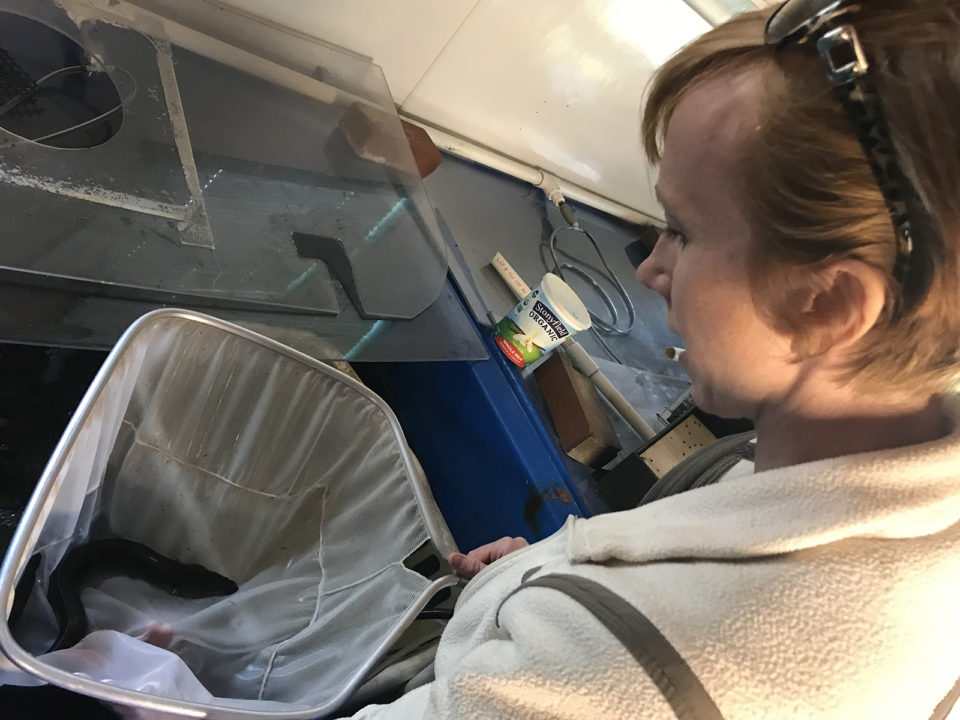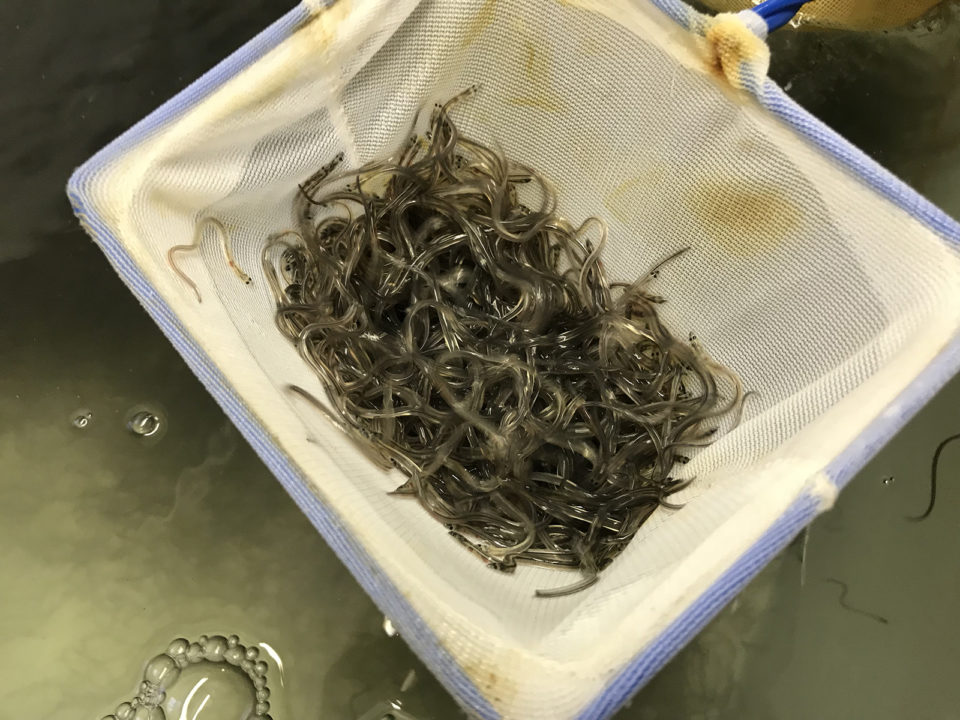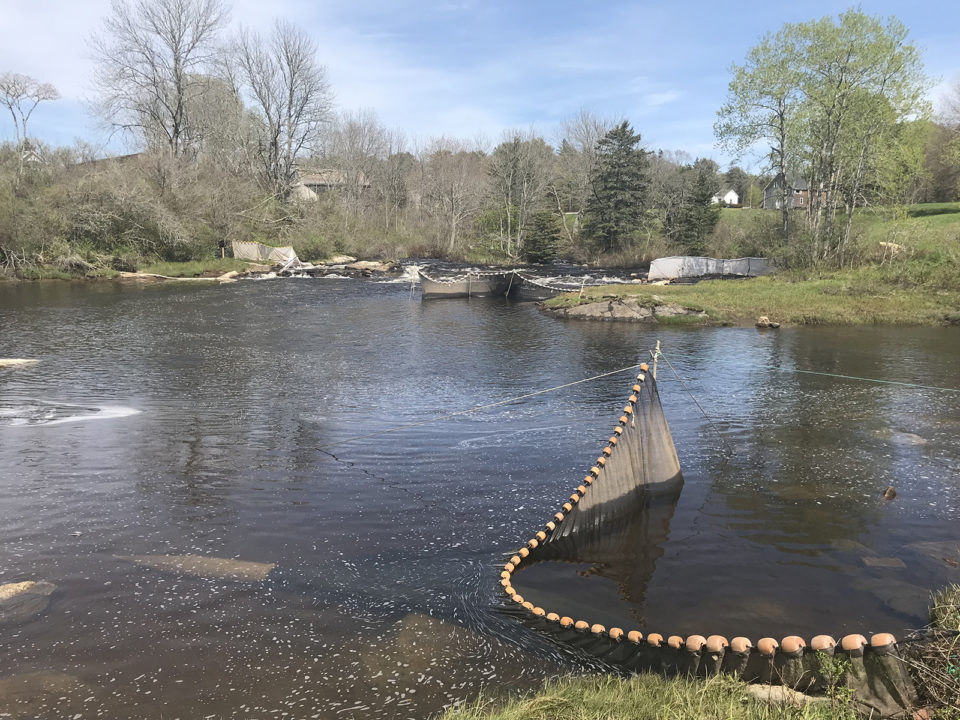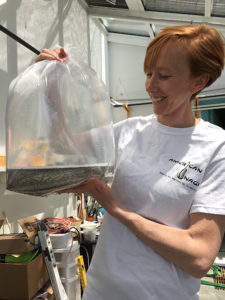Maine startup aims to shorten the sea-to-plate cycle for Anguilla rostrata

You could say Sara Rademaker is breaking a glass ceiling. In her case, it would be the glass eel ceiling.
Back in 2014, Rademaker launched American Unagi to shift eel cultivation to American soil, where the eels are from. Now, she’s raising glass eels from elvers to commercial size in a land-based recirculating aquaculture system (RAS) in Walpole, Maine.
When she began thinking about an aquaculture play, Rademaker had a couple of requirements. Whatever she ultimately chose to cultivate had to be land-based, and it had to be a Maine product. She turned towards eels in part because of the novelty, and partly because she saw an opportunity to do things better. And with a lot less shipping.
The vast majority of eels that American consumers buy, mostly for consumption in sushi restaurants as unagi, are imported. The current model primarily in use for eel production sees baby eels exported to Asian countries where they are grown to market size and then reimported. Along the way, there’s a fair amount of uncertainty – such as whether the eels have been treated with hormones and antibiotics – throughout that process.
While foreign producers often contend that they don’t use hormones, the ambiguity sticks with Rademaker. Some eels reimported to the United States have been shown to have residues of the antimicrobial substance malachite green and the banned antibiotic chloramphenicol. In April, the U.S. Food and Drug Administration issued an import alert about eels, and other seafood products, from China. About a decade ago, as much as 25 percent of sampled pangasius, catfish, dace, eel and shrimp from China tested positive for drug residues.

“The other level of uncertainty is you don’t know what species of eel you’re getting,” said Rademaker. “You don’t know if it’s legally caught, or illegally caught.”
According to Europe’s Sustainable Eel Group, where there’s a ban on exportation of the European eel, about 110 million young European eels have been illegally exported to Asian countries. The group also claims that for every eel legally eaten, three to five are illegally trafficked.
“There are eel species all over the world. A lot of those species are ending up in the farms in Asia. Some of them are legally harvested, some are illegally harvested; some are from fisheries that are managed, some are from fisheries that are not,” said Rademaker. “There’s that whole level of uncertainty. You just don’t know what eel you’re getting.”
Except at American Unagi, where Rademaker guarantees her eels are all the American species Anguilla rostrata and raised without hormones or antibiotics.
She also knows what her eels are eating, and the environment in which they are being raised: For now, seven RAS tanks in a cool, dimly lit room in the Darling Marine Center.
Rademaker received her first eels here in 2015; her second batch in 2016. Today, she has 5,000 eels – not including the thousands of elvers she received this spring – and is planning an expansion in a nearby mid-coast town. She expects to be in a commercial space – with capacity for 120 metric tons of eels – next spring and is closing on her first round of funding now. Rademaker’s idea is garnering interest, as she was named the winner of the short-pitch presentation competition at Fish 2.0 last fall.

Like many eel producers, Rademaker still relies on wild seedstock, and likely always will. American Unagi has its own buyer’s license this year and when she purchases the tiny, transparent elvers she pays market price, Rademaker said. In March of 2018, elver prices hit a record high at an estimated $2,700 to $2,800 per pound.
Rademaker also works with a local fisherman and wholesaler, Pat Bryant of Nobleboro’s PB Bryant Enterprises, who serves as an advisor on the fishery and supply side. Some of Bryant’s eels are also part of American Unagi’s current expansion. Instead of shipping her wrigglers to Asia, however, Rademaker instead drives them across a couple of Maine peninsulas to the Darling Marine Center. Much as the idea of breeding eels in captivity might seem enticing, she does not foresee that in her near future.
“The larvae cycle is complicated,” said Rademaker. While others may be making progress in attempts to breed them in captivity, to date the survival rate have not been the greatest. Relying on wild seedstock did give her a moment’s pause.
“I was hesitant, as it is a capture-based fishery, and I have an aquaculture background. But it’s a fish that’s been successful in land-based aquaculture,” she said.
Besides, there’s a highly regulated fishery practically right outside her door. In fact, the fishery was abruptly shut down this spring once Maine officials determined misuse of the newly implemented swipe-card system, intended to track the chain of custody and record transactions.
Those eels, they’re messy eaters – albeit with a promising 1.4 conversion rate. She feeds the eels by hand, letting them squirm into a smaller basket to feed. She’s at capacity here, and a good portion of these eels have reached market size – 150 to 250 grams each. They also deliver incredible yield: more than 70 percent when she does a smoked product.
For now, American Unagi is delivering live eels direct to chefs bi-weekly and only to those comfortable doing the processing themselves. Cafe Sushi in Boston has them on the menu, as do Portland, Maine, restaurants Solo Italiano, Hugo’s, Eventide Oyster Co., and Miyake. American Unagi was served at the James Beard House during Worcester’s Deadhorse Hill’s “New England Landscape” dinner in 2017.
To be able to work with a product that has been cared for and raised on such a small scale is really important for Masa Miyake, who uses only American Unagi for his freshwater eel dishes.

“Traditionally the eel that comes from Asia to the United States has already been processed, sauced and then frozen in large quantities,” said Miyake. “The opportunity to receive a live product yields such a different result and is also a great training tool for our staff.”
At Hugo’s and Eventide, co-owner and chef Mike Wiley had gotten some eels in the past – begrudgingly – from local fishermen. But he has been working with Rademaker’s eels for a couple of years now and loves them.
“I think her products are delicious. I think it’s super fresh. I think Sarah absolutely knows what she’s doing,” said Wiley. “She never brings us the eels that are undersized or look like they’ve been sitting around in the sun for hours. She maintains very high-quality standards, and that is the most important thing to us – getting that great local product.”
Plus, he likes the Maine-made story as well as the social implications.
“And I think that Sara is a really great example of a clever solution to the absurd status quo of: catching eels, shipping them over to Japan and China, fattening them up, cooking them, cryovac-ing them, freezing them and then sending them back to America to be consumed – from whence they came. It just doesn’t make any sense.”
Follow the Advocate on Twitter @GAA_Advocate
Author
-
Julie H. Case
Julie H. Case writes about travel, wine, food, science, mushrooms and more. Her work has appeared everywhere from Travel + Leisure to Wired.
Tagged With
Related Posts

Health & Welfare
Japanese eels: Progress in breeding and nutrition
The Japanese eel (Anguilla japonica) is cultured in ponds in Japan, China, the Republic of Korea and other countries. Ongoing research is addressing knowledge gaps in the domestication, controlled breeding and nutritional requirements of the species.

Health & Welfare
Eel production in Europe
After rapid expansion of glass eel culture in the mid-1990s was followed by overproduction, pricing problems, glass eel shortages and NGO pressures, European Union countries adopted national management plans for the eels. Importation of consumption eels was stopped, and exportation was phased out.

Health & Welfare
Japanese eel aquaculture in Korea
After a decade of research, Korea has produced individual glass eels for Japanese eel aquaculture. Despite dependence upon the wild seed, Japanese eel aquaculture production has been growing significantly and comprises over 27 percent of Korea’s freshwater aquaculture.

Intelligence
Buy-valves: Massachusetts farmers grow online oyster business
When Real Oyster Cult walked off with a $5,000 prize at Fish 2.0, it was solid affirmation that its online oyster commerce concept is on track for success.


